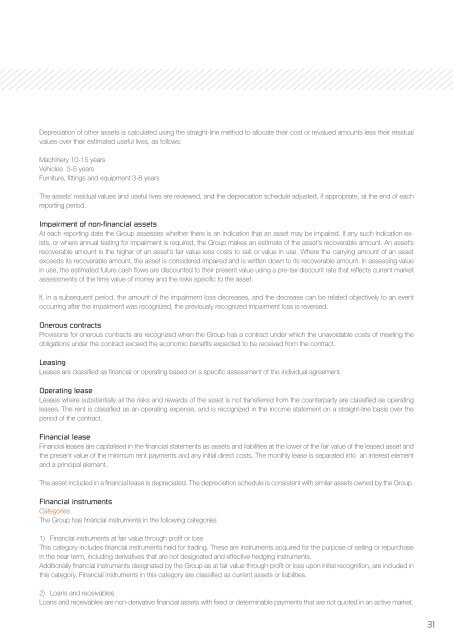REACH SUBSEA ASA
REACH SUBSEA ASA
REACH SUBSEA ASA
Create successful ePaper yourself
Turn your PDF publications into a flip-book with our unique Google optimized e-Paper software.
Depreciation of other assets is calculated using the straight-line method to allocate their cost or revalued amounts less their residual<br />
values over their estimated useful lives, as follows:<br />
Machinery 10-15 years<br />
Vehicles 3-5 years<br />
Furniture, fittings and equipment 3-8 years<br />
The assets’ residual values and useful lives are reviewed, and the depreciation schedule adjusted, if appropriate, at the end of each<br />
reporting period.<br />
Impairment of non-financial assets<br />
At each reporting date the Group assesses whether there is an indication that an asset may be impaired. If any such indication exists,<br />
or where annual testing for impairment is required, the Group makes an estimate of the asset’s recoverable amount. An asset’s<br />
recoverable amount is the higher of an asset’s fair value less costs to sell or value in use. Where the carrying amount of an asset<br />
exceeds its recoverable amount, the asset is considered impaired and is written down to its recoverable amount. In assessing value<br />
in use, the estimated future cash flows are discounted to their present value using a pre-tax discount rate that reflects current market<br />
assessments of the time value of money and the risks specific to the asset.<br />
If, in a subsequent period, the amount of the impairment loss decreases, and the decrease can be related objectively to an event<br />
occurring after the impairment was recognized, the previously recognized impairment loss is reversed.<br />
Onerous contracts<br />
Provisions for onerous contracts are recognized when the Group has a contract under which the unavoidable costs of meeting the<br />
obligations under the contract exceed the economic benefits expected to be received from the contract.<br />
Leasing<br />
Leases are classified as financial or operating based on a specific assessment of the individual agreement.<br />
Operating lease<br />
Leases where substantially all the risks and rewards of the asset is not transferred from the counterparty are classified as operating<br />
leases. The rent is classified as an operating expense, and is recognized in the income statement on a straight-line basis over the<br />
period of the contract.<br />
Financial lease<br />
Financial leases are capitalised in the financial statements as assets and liabilities at the lower of the fair value of the leased asset and<br />
the present value of the minimum rent payments and any initial direct costs. The monthly lease is separated into an interest element<br />
and a principal element.<br />
The asset included in a financial lease is depreciated. The depreciation schedule is consistent with similar assets owned by the Group.<br />
Financial instruments<br />
Categories<br />
The Group has financial instruments in the following categories<br />
1) Financial instruments at fair value through profit or loss<br />
This category includes financial instruments held for trading. These are instruments acquired for the purpose of selling or repurchase<br />
in the near term, including derivatives that are not designated and effective hedging instruments.<br />
Additionally financial instruments designated by the Group as at fair value through profit or loss upon initial recognition, are included in<br />
this category. Financial instruments in this category are classified as current assets or liabilities.<br />
2) Loans and receivables<br />
Loans and receivables are non-derivative financial assets with fixed or determinable payments that are not quoted in an active market.<br />
31


